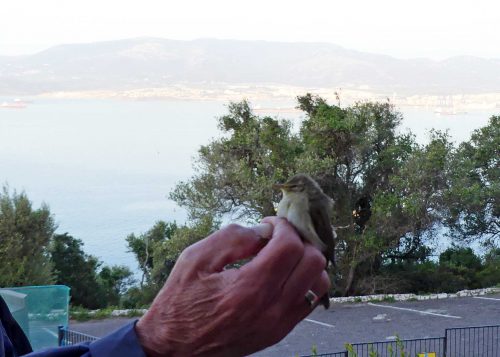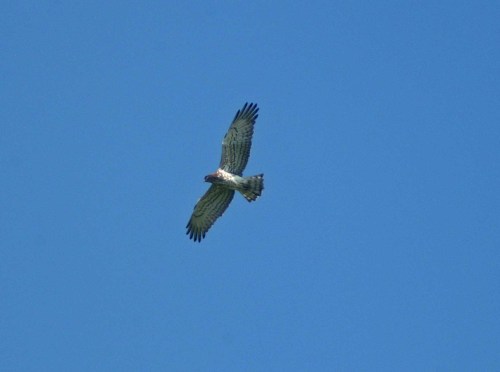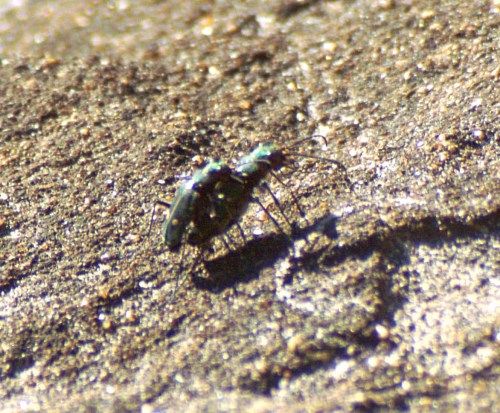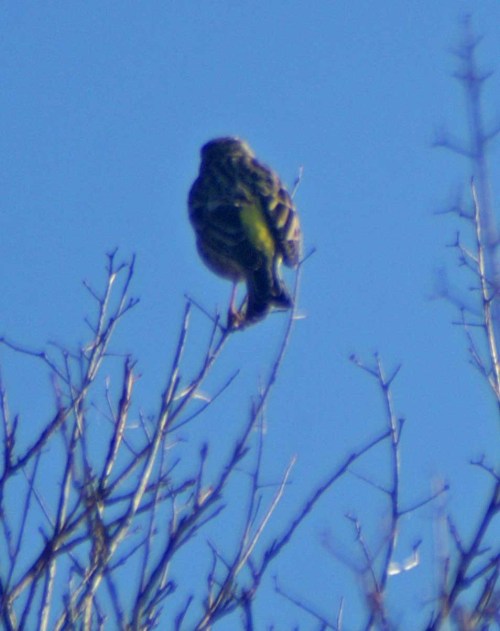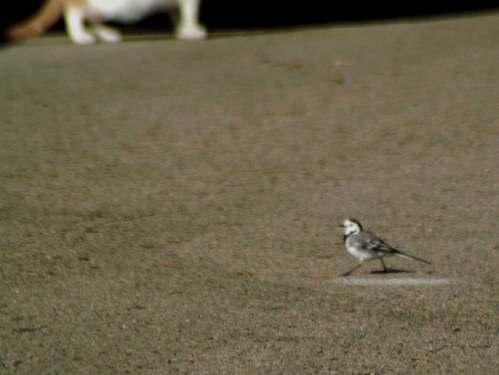March 20th-Day 2-Bird Observatory, Jew’s Gate, Upper Rock
07.30- We reached the Bird Observatory on the Upper Rock a little before it was properly light. Through a shroud of mist, dawn was subtle, washing the buildings of Algeciras, the hills beyond Gibraltar Bay and the Moroccan coast with diffused shades of amber.
The first thing I noticed was the absence of the Pillars of Hercules Monument directly below the Obs building. Apparently there had been a problem with the concrete roof of the public loos that forms its base and the Monument has been taken down and is currently propped up against nearby railings. I’m not sure how they got it there, it must be pretty weighty. Below is a photograph of the more usual view:
07:45 -We were here for birds as my friend and wonderful host Jill, is in training as a bird-ringer and was hoping for some practice in this highly skilled art, but thus far this morning had been disappointing for the current resident ringers. Not only was it cool and misty, but also and worse was that the cold wind was blowing in the wrong direction to bring migrating birds over the Strait in this direction, so the mist nets were very sparsely populated. If there are no birds to process and record, a day with a dawn start can seem very long up here, despite the amazing views.
 Gibraltar has long been recognised as a key location for observing the migration of birds and the Bird Observatory, run by the Gibraltar Ornithological and Natural History Society (GONHS), is a highly desirable venue for bird-watchers and in the appropriate seasons, bird-ringers, from many parts of the world. Perched high on the Upper Rock the views from the front door extending across the Bay of Gibraltar, over Algeciras and across the Strait to the Moroccan coast are truly stunning. The climate is appealing too, but of course it’s the opportunity to witness birds on their migration passages, often in great numbers, that draws them here.
Gibraltar has long been recognised as a key location for observing the migration of birds and the Bird Observatory, run by the Gibraltar Ornithological and Natural History Society (GONHS), is a highly desirable venue for bird-watchers and in the appropriate seasons, bird-ringers, from many parts of the world. Perched high on the Upper Rock the views from the front door extending across the Bay of Gibraltar, over Algeciras and across the Strait to the Moroccan coast are truly stunning. The climate is appealing too, but of course it’s the opportunity to witness birds on their migration passages, often in great numbers, that draws them here.
Inside the Field Centre, suspended on hooks above the ringing bench, a male Sardinian Warbler and a Willow Warbler were waiting in little cotton bags to be ‘processed’. Within minutes the birds were quickly and carefully weighed, measured, ringed, entered into the record book and released.

0757-Sardinian Warbler processed and ready to go. Note the manicured fingernails of a female bird ringer – it’s not a job strictly for the boys
08.00 – By way of a diversion, the moth light trap is opened up to reveal last night’s bounty. There were a good number in there of an interesting variety of species ranging from tiny micro-moths to a spectacular Tiger Moth. I left it to the experts to ooh and aah at the really tiny ‘micros’ and concentrated on the bigger, showier ones that I had a hope of recognising if I ever see them again! I knew the lovely Tiger Moth with its rich red underparts and was quite taken with the Shark Moth, so-called because of its shape in profile.
08.17 – Excitement as an incoming Marsh Harrier dashes overhead-the sighting was brief, but we thought a male as has black wingtips.
08.35 Another inspection of the mist nets brings a female Goldfinch
0919-In the sheltered ‘garden’ area at the side of the Obs there is a small pool of water inhabited by frogs. As the sun gathered strength the warmth brought them out to sunbathe and the males began to sing. Their human neighbours were not as happy to hear them as I was; apparently they’d be singing loudly for most of the night. I don’t know his species, but according to the GONHS website, frogs present here in Gibraltar are introduced and of the species Rana (Pelophylax) perezi (Perez’s Marsh Frog). Maybe someone will confirm or correct me?
Other insects were also appreciating the sunshine; an interestingly coloured millipede warmed himself on a wall and little bees were gathering pollen and nectar, particularly from Rosemary and Tree germander.
There are wildflowers here too, including some elegant and highly fragrant Freesia blooms. Not a native plant, but one-time introduction originating in South Africa, it is now naturalised in a variety of locations around the Rock. It’s much tougher than it looks, here it competes for headroom with other native plants, but it is also found pushing up through cracks in paving and against walls.
Another plant flowering is the Pitch Trefoil or Bitumen Pea, so called because if crushed the plant releases an aroma uncannily like that of the tar they use to repair road surfaces, which happens to be one of my life-long favourite smells, so I love this plant!
09.55 – A juvenile male Blackcap has been ringed and is released
09.44 – Busy with the wildflowers I missed a sighting of a Dark-phase Booted Eagle, so no photo, but I did catch the single Black Kite as it passed overhead.
The wind changed slightly, but was still not from the most desirable westerly direction. Mist still hangs over the Strait and the Bay, but the appearance of the Black Kite prompted scanning with binoculars as these most numerous of incoming raptors frequently travel together in variously sized flocks. There were more! In conditions such as today’s when visibility is limited, birds often fly close to the surface of the water and have to flap their wings to maintain momentum, expending precious energy. Arriving close to land again and once they can see where they are and want to be, they begin to circle seeking currents of rising warmer air. These ‘thermals’ will enable them to gain height without flapping and once they are up high they are able to glide towards their destination on the wind.
Jill retrieved a very feisty female Blackbird from the mist net. Already ringed, she was clearly a local resident bird and a brood patch on her breast showed she was nesting, so was quickly set free.
My last pictures of the morning here was of a large Wall Lizard, that looked like it was in the process of shedding its skin.
and another wildflower, this one growing at the front of the building, White Mignonette, is also planted in gardens as an ornamental.
A cold but very varied and enjoyable morning, enhanced by several hot cups of tea and a hot-cross bun. Looking forward to a bit of a rest, lunch and a walk up to the Alameda Botanical Gardens this afternoon…….



